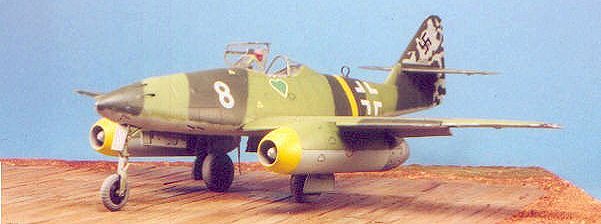
|
KIT: |
Tamiya 1/48 Me-262A-2a |
|
KIT # |
61082 |
|
PRICE: |
$45.00 |
|
DECALS: |
Three aircraft |
|
REVIEWER: |
|
|
NOTES: |
Aftermarket used: |

|
HISTORY |
Reading the history of the Messerschmitt Me-262 - the world's first operational jet fighter - one can only conclude that if World War II had to be fought, we were fortunate to have a moron like Adolf Hitler for an opponent. Had anyone else been in charge, we might well all be speaking German (any study of the relevant history will reveal, however, that the only person on the planet who wanted World War II was Hitler).
Following the victories in the West in 1940, the idiots of the Reichluffartsministerium determined that any project not capable of coming to fruition within 18 months would be scrapped. This effectively put the entire German jet fighter program on hold, to the ultimate benefit of the Allies when not one German jet aircraft reached operational effectiveness in worthwhile numbers. This was particularly fortunate when one compares the performance of the Me-262 with the Meteor I and III, the only Allied jet fighter that could have opposed it, had it reached operational units in early 1944 as Adolf Galland believed it could have been; that it did not was due to the other "command decision" - Supreme Dummkopf Hitler's determination in the fall of 1943 that the airplane should be produced as a bomber.
In an interview, Galland stated, "I believe the Me-262 could have been made operational as a fighter at least a year and a half earlier, and built in large enough numbers so that it could have changed the air war. It would most certainly not have changed the final outcome of the war, for we had already lost completely, but it would have probably delayed the end, since the Normandy invasion on June 6, 1944, would probably not have taken place, at least not successfully if the 262 had been operational. I certainly think that just 300 jets flown daily by the best fighter pilots would have had a major impact on the course of the air war."
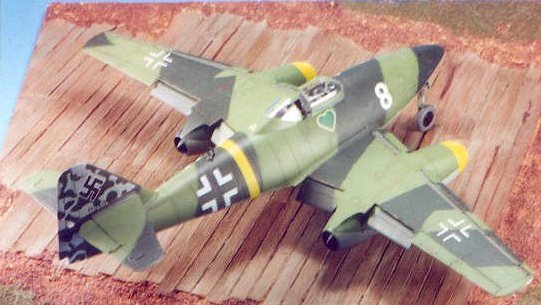 As it was, even with
the full panoply of official Nazi mendacity arrayed against it, the Me-262 did
reach initial operational capability in the summer of 1944, and gave Allied air
force commanders fits from the day a Mosquito crew reported evading one, right
up to V-E day.
As it was, even with
the full panoply of official Nazi mendacity arrayed against it, the Me-262 did
reach initial operational capability in the summer of 1944, and gave Allied air
force commanders fits from the day a Mosquito crew reported evading one, right
up to V-E day.
An idea of how effective the airplane could be against its Allied opposition can be seen in the career of Major Kurt Welter, the top-scoring Wilde Sau pilot with 30 victories by the end of 1944, who began using the Me-262 in the wilde sau role in January 1945; the first time he flew the Me-262 at night over Berlin, he shot down four Mosquitos in one mission. By the end of April he had shot down an estimated 20+ British bombers - almost all Mosquitos, which before then had been virtually immune to interception by German piston-engine fighters; this makes Welter - not Heinz Bar - the top-scoring jet fighter pilot of the war, as well as the second-highest scoring jet ace of history, behind only Col. Yevgeny Pepelyaev of the VVS-PVO in Korea (21 victories). Several other members of Kommando Welter scored well against the Mosquitos of the Light Night Striking Force during the seven weeks the unit saw combat during March and April 1945, prompting Bomber Command to send a huge raid against their base at Magdeburg on Easter Sunday, 1945.
1,420 Me-262s of all variants were produced by the end of the war. Fortunately for history, the words that best describe this technological wonder are "too little, too late."
Walter Nowotny and the Me-262:
Walter Nowotny did not join the Luftwaffe until October 1939, after the Polish Campaign. Following completion of training, he was assigned to JG54, the Green Hearts Geschwader, at the conclusion of the Battle of Britain. He did not score any victories until the summer of 1941, following the invasion of the Soviet Union, when he shot down three I-153s, after which he survived being shot down and spending three days in his dinghy in the cold Baltic Sea. Nowotny continued to make multiple scores in his fighting: a bit over a year later, on August 13th 1942, he scored 9 in one day and 7 more on the 21st. On September 4, 1942, he was awarded the Knight's Cross on the occasion of his 56th victory; by September 22, he was awarded the Oakleaves and Swords. On October 25, aged 21, he assumed command of 9th Staffel. He became the first fighter pilot anywhere to score 250 kills by October 12, 1943, when he was awarded the Diamonds.
Following a successful tour as commander of Schulegeschwader 101, Nowotny was given command of the first jet fighter unit, which was created from Erprobungskommando 262; originally formed in December 1943 to test the new Me-262, the unit had received its first aircraft in April 1944, and scored their first victory - a photo-recon Mosquito - on July 26, 1944. Galland was looking for the right type of pilot, someone daring and successful who could lead by example of courage and determination: Walter Nowotny had all of these qualities.
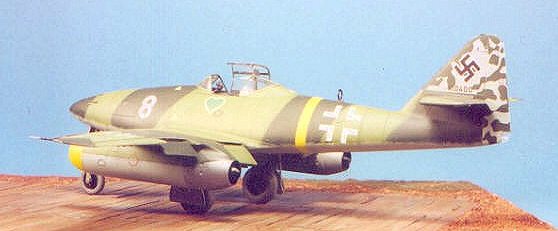 Kommando Nowotny was
formed at Achmer in September, 1944, and became operational on October 3, 1944.
The unit claimed its first kill - a B‑24 - on October 7th. Nowotny was able to
obtain the services of III/JG54 - the first operation Fw-190D-9 unit - to
provide cover against roaming Allied fighters during the takeoffs and landings
of the Me 262.
Kommando Nowotny was
formed at Achmer in September, 1944, and became operational on October 3, 1944.
The unit claimed its first kill - a B‑24 - on October 7th. Nowotny was able to
obtain the services of III/JG54 - the first operation Fw-190D-9 unit - to
provide cover against roaming Allied fighters during the takeoffs and landings
of the Me 262.
On November 8, 1944, Nowotny led five other Me-262s against an 8th Air Force raid, during which he scored his only two victories in the Me-262, a B-24 and a P-51. Though no one saw the final combat, Galland - who was at Achmer at the time - heard Nowotny radio shortly after reporting his kills "I'm burning! My god! My god! I'm burning!" Nowotny had taken a hit in one engine. As he attempted to regain the field on one engine, several P-51s braved the murderous flak defending the field to swoop down and attack the damaged Me-262.
Galland later described the crash: "I stepped outside to watch his approach to the field, when an enemy fighter pulled away not far from us. I heard the sound of a jet engine, and we saw this 262 coming down through the light clouds at low altitude, rolling slightly and then hitting the ground. The explosions rocked the air, and only a column of black smoke rose from behind the trees. We took off in a car and reached the wreckage, and it was Nowotny's plane. After sifting through the wreckage, the only salvageable things found were his left hand and pieces of his Diamonds decoration."
Kdo Nowotny was disbanded shortly after Nowotny's death. The unit had claimed 22 aircraft with a loss of 26 Me-262s, eight of which were due to accidents and mechanical failures. Planes and pilots of Kdo Nowotny would be used to create III/JG7, which would see combat again in March and April 1945.
In "Stormbird Rising," RAF Typhoon pilot John Golley recalls: "Early in November 1944 there was a rumour going around that Nowotny, the German ace flying Me-262s, had been shot down. Nobody, as far as I was aware, was particularly excited about it, and nobody had claimed the kill. All I heard was that a Tempest squadron had got him. There was sadness rather than elation that such a great fighter pilot had been killed."
|
THE KIT |
As to what you'll find opening the box of Tamiya's Me-262, I refer you to Scott's First-Look Review .
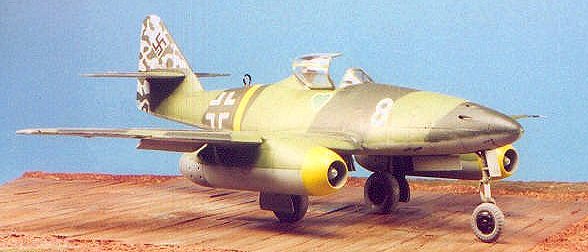 My own assessment is
that I am not impressed with this kit, at least out of the box. Other than a
bit better parts fit, the kit does not offer any real advance over the 24-year
old Monogram Me-262. Oh yes, modelers will howl that it has "recessed panel
lines." Hate to tell you this, lads, but the real Me-262 (I used to be around
one once a month for 20 years while it resided at Planes of Fame Air Museum) had
lapped panels, which means that - as a model - the raised panel lines of
the Monogram kit provide a more accurate look than this "state of the art" kit.
The cockpit of the Monogram kit is at least as accurate as that of this kit.
For a quadrupling in price compared to a Monogram kit, Tamiya has not provided a
quadrupling of quality. This is particularly so when you realize Tamiya did not
provide at least the leading-edge slats - which were always fully-deployed when
on the ground - which they were able to do with their Bf-109E kit, as well as
the dropped flaps for which their other kits are all famous.
My own assessment is
that I am not impressed with this kit, at least out of the box. Other than a
bit better parts fit, the kit does not offer any real advance over the 24-year
old Monogram Me-262. Oh yes, modelers will howl that it has "recessed panel
lines." Hate to tell you this, lads, but the real Me-262 (I used to be around
one once a month for 20 years while it resided at Planes of Fame Air Museum) had
lapped panels, which means that - as a model - the raised panel lines of
the Monogram kit provide a more accurate look than this "state of the art" kit.
The cockpit of the Monogram kit is at least as accurate as that of this kit.
For a quadrupling in price compared to a Monogram kit, Tamiya has not provided a
quadrupling of quality. This is particularly so when you realize Tamiya did not
provide at least the leading-edge slats - which were always fully-deployed when
on the ground - which they were able to do with their Bf-109E kit, as well as
the dropped flaps for which their other kits are all famous.
I am particularly disappointed that Tamiya chose to make the thoroughly-uninteresting Me-262A-2a bomber version, as opposed to the 4-gun fighter version. As Brett Green demonstrated in his full-build review at HyperScale, it takes only a modicum of modeling ability to turn the OOB kit into the fighter if one so wishes.
Fortunately, for the modeler who wants to turn a $45 kit into an $83 kit, Cutting Edge has released four aftermarket resin sets that provide slats/flaps/control surfaces, corrected wheels, 4-gun nose, and detailed cockpit. In my estimation, after building this kit, if you are going to do only one Tamiya Me-262 and you want a definitive model sitting on your shelf when you're through, these sets are well worth it, since the resulting model looks a whole lot better than the OOB model. (If you want a lot of Me-262s in your collection, go to swap meets and pick up the Monogram kit.) {The editor would like to add that even the Dragon ones have seemed to come out of the woodwork and can be found for around $20}
The seat of the Cutting Edge cockpit set provides molded-in detail of the seat cushion and seatbelts, while the instrument panel and side panels provide much finer detail than do the kit parts. The fowler flaps come with a wing plug for each flap that allows them to be deployed properly so they are "slotted" in the down position. The slats are suitably thin, with leading edge plugs; both slats and flaps are easy to install if you commit that radical act of reading the instructions.
|
CONSTRUCTION |
As regards construction of the basic kit, I read Scott's full-build review and avoided the problems (self-inflicted, I might add, Ed) he faced in installing the nose weight.
To assemble the slats and flaps, you will have to cut off the relevant areas of the wings before assembly. The wing sub-assembly is then glued together. The wing plugs for the slats and flaps fit easily with only a bit of pre-fitting necessary. Using slower-curing cyanoacrylate glue will allow you the time to position them properly once you have glue on them.
|
PAINT & DECALS |
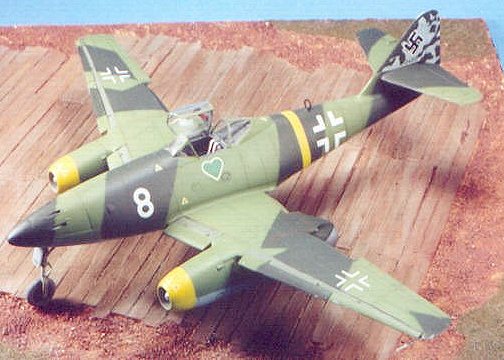 Paint:
Paint:
I have never seen a photograph of what is commonly called "Nowotny's Me-262," though the many color profiles that claim to "document" this airplane are all agreed it was in the "solid" camo and in two greens, rather than the 74/75/76 of earlier fighters. German paint orders at the time the camouflage changed over to the "late war" colors specified that existing stocks of paint should be exhausted. Therefore, I painted my model with RLM82 Lichtgrun and RLM70 Schwartzgrun (in place of RLM83 Dunkelgrun), with the undersurfaces in RLM76. The fuselage stripe and intakes of the jet engines were painted RLM04 Gelb. I painted the rudder and vertical fin in RLM76, and planned to use the "tadpole tail" decals from the Cutting Edge decal sheet 48-103 (Me-262 Kommando Nowotny). These were all applied over a "pre-shading" of black airbrushed over the panel lines, with each color lightened and re-sprayed after initial application to provide contrast and depth; I did not think this airplane lasted long enough for the paint to "fade," especially not in the stormiest fall season in a century, which was the case with that fall of 1944. All paints were Gunze-Sanyo. After applying a coat of Future to the finished paint scheme, it was time for markings.
Decals:
I had decided to do "Nowotny's Me-262" because the kit as created here makes up into an early-production Me-262, identifiable from the navigation light position in the rudder. Of the Me-262s supposedly flown by aces, it was the one I was pretty sure was an early-production airplane. I say "supposedly flown by aces" because I don't think any of the aces had an Me-262 that was "theirs." This was a difficult airplane to maintain, and serviceability was such that the majority of the aircraft assigned to any unit at any given time were probably down for maintenance. Like Joe Foss and Marion Carl at Guadalcanal, I am confident that Walter Nowotny, Johannes Steinhoff, Adolf Galland, Heinz Bar and the rest flew "the first one they came to that worked" on their missions, and that the conditions of the war were such there was not time for "prettifying" these airplanes with personal markings. However, for the sake of this model (I have a model of "Marion Carl's Wildcat" - which was nothing more than a hangar queen at Espiritu Santo with victory stickers on it that Carl sat on for the photographers one afternoon), I decided to follow the "expert profiles" and do it that way. Some profiles show the airplane with a Grunherz insignia, others don't; I made the personal choice to have it on mine.
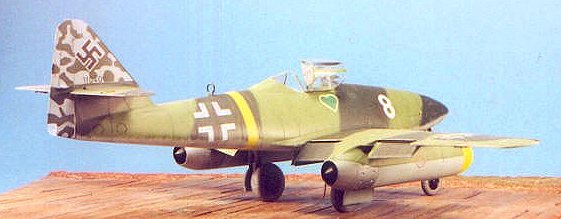 I used the "tadpole
tail" and the detail stencils from the Cutting Edge sheet 48-103, and took the
national insignias and Nowotny's "Weiss 8" from the old Aeromaster "Top Guns of
the Luftwaffe" special sheet. The Grunherz came from the decal dungeon.
I used the "tadpole
tail" and the detail stencils from the Cutting Edge sheet 48-103, and took the
national insignias and Nowotny's "Weiss 8" from the old Aeromaster "Top Guns of
the Luftwaffe" special sheet. The Grunherz came from the decal dungeon.
When all was dry, I gave the model another coat of Future, followed by several coats of thinned Testor's Dullcote to "flatten" the finish to the level I wanted.
Final Assembly:
The landing gear sub-assemblies were attached with no trouble. I unmasked the canopy and assembled it in the open position. Other than a bit of scuffing of the area where the pilot would enter the cockpit, I did not "weather" the model further.
|
CONCLUSIONS |
If you "just gotta have a Stormbird" and can't wait for Tamiya to release the 4-gun version, this is the way to go. Even if you do wait for the nose change, you'll still need the slats and flaps, and the Cutting Edge parts in the cockpit make it look far better than you get out of the box.
If you would like your product reviewed fairly and quickly where it will be seen by well over 150,000 visitors a month, please contact me or see other details in the Note to Contributors.